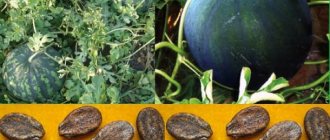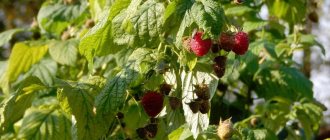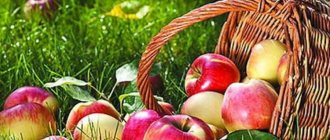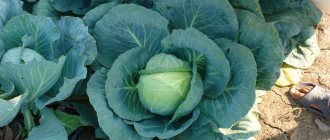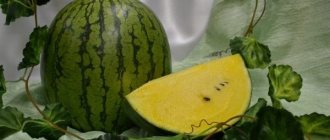To grow the Sugar Baby variety on your plot, you need to know some of the subtleties of the process. Read below about the characteristics of watermelon, rules of cultivation in different regions, conditions of collection and storage, as well as other useful information.
watermelon variety “Sugar Baby”
Watermelon “Sugar Baby” has high taste qualities
the universal variety “Sugar Baby” is popular among gardeners, both professionals and amateurs
General characteristics and history of the variety
Sugar Baby or Sugar Baby is one of the oldest and most popular varieties. It was bred by foreign breeders in the 50s of the last century. In 2008, it was included in the State Register for the Central Black Earth region of the Russian Federation, which includes the Belgorod, Kursk, Lipetsk, Oryol, Tambov and Voronezh regions.
This is an early ripening variety of watermelon, that is, the fruits are harvested 75-85 days after germination. The plant is climbing. The main vine does not exceed 1.8 m in length, so it can be grown in a greenhouse on trellises. The leaves are medium gray-green in color, strongly dissected. The fruit is most often spherical and smooth. The bark is thin but dense, colored a rich dark green.
Up close, stripes of a darker color than the main color become visible across the entire surface.
Weight depends on the growing region. In warmer areas, with a lot of sunny days, the weight reaches up to 6 kg, on average - 3-4 kg. In greenhouses, a ripe fruit can weigh about 1 kg. The dark red flesh is juicy, grainy, sweet and tender. However, in low light conditions its taste deteriorates. It becomes watery and tasteless. The seeds are small and brown. Their surface has a characteristic spotted pattern.
Description of the watermelon variety Sugar Baby
The pulp is rich red, very juicy, coarse-grained
Sugar baby is an early (ultra-early) variety. From the date of emergence to fruiting, an average of 2.5 months pass. This is a medium-sized plant, the vine of which grows 2 meters or a little more. The leaves are large, rich green. The stems are fleshy and can break if bent incorrectly.
The Sugar Baby watermelon variety is difficult to confuse with other species because it has a bright appearance. The fruits are medium-sized, weighing up to 6 kg, although usually around 2-3 kg. The peel is dark green. There is a pattern, but it is only visible from close up. It is several tones darker than the main background, and is not very clearly expressed, so from a distance the watermelon may seem just green.
The peel is not thick. The pulp is rich red in color, very juicy, coarse-grained. After full ripening it becomes straight sugar, very sweet. The seeds are contained in average quantities, they are small, black or dark brown.
Advantages and disadvantages
The benefits of Watermelon Sugar Baby include:
- early ripeness;
- high commercial qualities;
- thin peel;
- transportability of fruits;
- long-term storage;
- unpretentiousness;
- resistance to spring temperature drops;
- drought resistance;
- immunity to various diseases, including fusarium.
The disadvantage is the small size of the fruit and long ripening in a humid climate, so it is necessary to take a responsible approach to choosing the place where the plant will grow.
Top dressing
The bed for the melon plant should be prepared in the fall. To do this, the land is fertilized with potassium and phosphorus fertilizers.
Tomato Sugar giant: characteristics and description of the variety
During the period of two or three leaves it is worth feeding. For this purpose, fertilizers are used only in liquid form: potassium-phosphorus and nitrogen. To increase the yield, it is necessary to alternate organic and mineral fertilizing.
Organic fertilizers can be of plant or animal origin. The best fertilizer of the latter type is manure or chicken droppings.
Important! The plant cannot be fertilized with concentrated manure - this can lead to withering of the fruit, loss of color brightness and accumulation of harmful substances in the berry. The concentrate is diluted in a ratio of 1/5.
After feeding, the plant is watered. Fertilizers of animal origin alternate with plant nutrition. To do this, infuse herbs (preferably hay, wood ash).
Watermelon Sugar Baby
Mineral fertilizers: phosphorus, magnesium, calcium, potassium, sulfur, nitrogen.
Nitrogen fertilizing is introduced gradually so that all the strength of the plant does not go into the greenery.
Features of cultivation in different regions
To obtain sweet, ripe fruits, you definitely need good lighting. The watermelon must be exposed to sunlight for at least 8 hours. Choose an open, sunny place. No shadow should fall on it from nearby buildings, trees or tall plants. The best option is to plant watermelon on the southern and southeastern slopes.
Subtleties of growing in other regions:
- In cooler climates, gardeners mulch the soil with a black film that accumulates heat.
- In areas with short summers, experts recommend planting watermelon seedlings. Planting in open ground is also possible, but it does not always end successfully. In low summer temperatures, seeds may not germinate.
- In the northern regions, watermelon is grown in polycarbonate or film greenhouses. If necessary, use additional lighting.
The plant is pollinated by insects. However, if the windows in the greenhouse are all closed due to cold weather or the weather is cloudy outside, pollination is carried out manually.
Watering
The variety does not like an abundance of moisture. About 30 liters of water per square meter will be required. To prevent the root system from freezing and rotting, the plant is watered with warm water. Watering is carried out in the evening so that the scorching sun does not burn the leaves.
Water the plant only during the period of flowering and the appearance of ovaries. When the fruit begins to ripen, watering should be stopped so that the berries do not burst from excessive moisture.
During periods of prolonged rainfall, the fruits are covered with film or glass. Bricks are placed under the ripe berries to retain heat longer.
Towards the end of July - beginning of August, you can collect the first fruits. To determine the ripeness of the fruit, you should pay attention to the following characteristics:
- A completely dry tail.
- When the berry is lightly squeezed, a characteristic grinding sound is heard.
Preparing the soil for planting
Watermelon does not tolerate peat soil, as well as soil with a large amount of clay and black soil. In order for the plant to grow well, it is planted in a light, loose substrate enriched with minerals.
The best precursor of the crop is radish. In this case, you don’t have to be afraid that the watermelon will be attacked by spider mites. But it is better not to grow it after pumpkin representatives, since they have common pests and diseases.
Yellow spot on the side.
This spot is not a sign of unripe watermelon or disease. The watermelon simply lay in this place on the ground and the sun, naturally, did not reach there.
Yellow spot on watermelon (large)
It is also easy to determine the ripeness of the berry by this spot. It should be as yellow as possible.
But when buying a watermelon with a white circle on the side, you risk running into a tasteless product.
The size of the spot also requires attention. Be aware that a large spot indicates that the watermelon has been ripening for a long time in not too warm conditions. Because of this, the fruit loses its taste and becomes less juicy.
Growing methods
There are 2 main methods of growing watermelon - seedlings and non-seedlings.
Seedless
It is suitable for warm, sunny areas where there are no recurrent frosts and summers are long and hot. Before sowing, seeds are prepared:
- First they are sorted and rejected. “Dummy” seeds can be easily identified if the seeds are placed in a glass of salted water. 10 minutes are enough for high-quality seed material to sink to the bottom, and hollow seeds to float to the surface.
- Selected seeds are then dipped in a slightly pink solution of potassium permanganate for several hours for disinfection.
- The next stage is to fill them with hot water (50°C) and leave for a day. This procedure allows you to speed up seed germination.
- Then the water is decanted, the seeds are blotted with a dry cloth and sown immediately in open ground.
Planting is carried out as soon as the soil has warmed up to +15°C at a depth of 10 cm. Holes are dug at a distance of 1 m from each other. The row spacing is 1.5 m. The seeds are planted to a depth of 3-5 cm. Sowing is usually done at the end of April.
Seedling method
It is used in temperate climates, as well as in areas with short summers. Usually seedlings are planted in a greenhouse. In this case, there is a high probability of obtaining a ripe, high-quality harvest. Seeds for seedlings are sown in mid-spring. The soil is prepared loosely with a large amount of sand and mineral fertilizers (the latter can be replaced with wood ash and humus).
Before sowing, seed material is prepared in the same way as before planting in open ground. Sow them immediately in separate containers so that the delicate roots of the plants do not become intertwined and are not injured during transplantation. The container should be no more than 8 cm deep.
The seeds are buried 2-3 cm. The cups are kept warm at all times, in a well-lit place; the soil should not dry out. It is planted in a permanent place when the 3rd true leaf is formed. After transplanting on cold nights, the seedlings are covered with cut plastic bottles or film.
Features of sowing seeds
Compliance with all the subtleties of sowing is considered one of the main conditions that ensure plants not only intensive growth, but also increased productivity. To do this, you need to follow both a specific sowing scheme and carry out various preparatory measures in advance.
They include seed processing and activation, as well as soil preparation. In this case, it is enough to strictly observe all the standard measures that are put forward by the basics of agricultural technology for growing melons.
Preparing the soil for sowing
Watermelon grows well and bears fruit only on loose and well-fertilized soil , so the area must be carefully prepared before sowing. They begin the procedure in the fall, after leaf fall. At this time, the soil on the site is thoroughly cleared of remnants of vegetation and other debris, and then the planting site is well plowed to a depth of about 25–30 cm.
If the fertile soil layer in the area is less thick, the plowing depth can be reduced. If the soil on the site is depleted, the soil must be fertilized before autumn plowing. To do this, add manure, humus or compost on top at a rate of 5 kg/m².
After wintering, the soil is plowed again, and the loosening depth can be reduced to 20 cm. Immediately 3-4 days before sowing the watermelon, harrowing of the plowed land is carried out in 2 tracks. After this, the substrate under the crop becomes soft, moisture- and breathable, which allows for maximum yield.
Preparing watermelon seeds for sowing
Watermelon seeds also require all kinds of preparatory measures before sowing. The first thing to do is to disinfect the seed from fungal spores and dangerous bacteria.
To do this, the seeds are soaked in special sterilizing agents:
- in a 70% alcohol solution, for 5–10 minutes;
- in 2% potassium permanganate, about 20–30 minutes;
- in 15% hydrogen peroxide, no more than 10 minutes.
Caring for a Sugar Baby
Caring for the variety involves following the rules of watering, timely application of fertilizing and some additional features.
Watering
Water the plants rarely, but abundantly. When watermelons ripen, stop watering completely, otherwise they may crack. For irrigation, always use only warm water. The procedure is carried out in the evening, when the heat subsides.
After watering or precipitation, they always loosen the soil until the lashes grow.
Top dressing
Fertilizers are applied in several stages:
- When 2-3 leaves appear, the watermelon is fed with nitrogen fertilizers. This will give impetus to the growth of green mass. After 15 days, fertilizing is repeated.
- During the formation of ovaries and ripening of fruits, mineral fertilizers are applied - potassium-phosphorus. Particular attention should be paid to potassium-containing fertilizers. They promote greater formation of female flowers, increase the plant’s immunity, and improve the taste of the fruit.
Additional care
All weeds must be removed around young plants. During prolonged rains, the resulting fruits are covered from above and placed on cardboard, bricks or wooden boxes to prevent them from rotting. If the watermelon is grown on a trellis, then as they ripen they are tied up with a net. The gardener directs the growing vines in the direction he needs, and sprinkles the root with earth so that additional roots are formed.
When pests attack or diseases develop, use appropriate insecticides and fungicides. Solutions are prepared and processed strictly following the manufacturer's instructions.
Ideally, of course, you would do without chemicals altogether, since watermelon tends to accumulate nitrates and other substances.
Optimal conditions for growing in Siberia
In Siberia, the Sugar Baby watermelon is grown by seedlings. Seeds for seedlings are sown in late April - early May. When growing outdoors, it is better to play it safe and make shelters in the form of arcs or cover the plantings with covering material. On cold nights, plants are also covered. In general, the care is the same as when growing in other areas.
We recommend reading the article on how to plant and grow watermelon in Siberia.
Growing watermelon Sugar baby: seedlings or open ground
Growing this variety of watermelon is no more difficult than cucumbers. It is important to correctly determine the growing method:
Seedling method
This method is recommended for use in the northern regions of Russia. To grow strong and productive seedlings, you must follow some sowing rules:
- before sowing, soak the seeds in warm water 50-60 degrees Celsius - warming the seeds will significantly increase their germination and yield;
- plant the seeds in the substrate and cover with film;
- in 7-10 days the first shoots will appear.
Growing watermelon Sugar baby using seedling method
The age of seedlings for planting in the ground should not exceed 30 days. By this time it is necessary to prepare the holes:
- the distance between them should be at least 1 m, since the length of the vine can reach 1.5-1.8 m;
- Ash and compost are first added to the soil;
- if the soil is heavy, you need to add sand to the hole.
The soil for planting seedlings should not be cold, so it is spilled with warm water. When planting, do not deepen the plant too much - this can lead to its rotting. After planting, the holes are covered with glass or film for the first time.
Seedless method
In the southern regions, you can start sowing seeds in the second half of April, or in early May: when the top layer of soil warms up to 10-12 degrees Celsius. The planting depth is 2-3 cm, then covered with film. A week later, when sprouts appear, the protection can be removed.
Agricultural technology
The sprouts must be regularly hilled, and the first vines that appear must be sprinkled with earth - this will strengthen the plant’s root system and enhance nutrition. Watermelon Sugar Baby loves sun and open areas, but a little shade will only benefit it: the sweetest berries ripen in the partial shade created by weeds. Therefore, you should not remove weeds completely. Weeds will also allow moisture to remain in the soil longer.
Sugar watermelon grows well in the partial shade of other plants
With proper care and suitable weather conditions, the first ripe fruits can begin to be collected in late July - early August.
Collection and storage
There is no exact time for harvesting watermelon, since each region has its own and ripening depends on weather conditions. However, there are a number of external signs that indicate the ripeness of the fruit:
- dry ponytail;
- dull sound when tapped;
- fading leaves and stems;
- characteristic crackling sound.
Store watermelon in the refrigerator, basement and cellar at a temperature of +2 to +5°C. The main thing is that the rind of the fruit is without damage - scratches, dents or cracks. The optimal weight of watermelons for storage is 4-5 kg.
In the video below, the gardener conducted a tasting of the hand-grown watermelon variety “Sugar Baby”:
Reviews of watermelon Sugar Baby
You can hear a lot of positive reviews about the Sugar Baby watermelon, and this is not surprising, because it is sweet and profitable for sale.
- Dmitry Dolgin : “I have been growing the Sugar Baby variety for sale for more than 5 years. Buyers love it, first of all, for its convenient size - it’s easy to choose for one person or a large family. It looks beautiful, bright, the flesh stands out, and the taste is pleasing.”
- Ekaterina Afanasyeva : “It’s a good variety, due to the fact that the peel is thin, I always buy it for winter preservation. It stores well in jars, the pulp does not disintegrate, and the taste is incomparable in winter. Although it is delicious fresh, we grow it every year. We haven’t received large ones yet, but there were a lot of small ones, 1-1.5 kg, red and sweet ones.”
- Mikhail Steklov : “The Sugar Baby watermelon variety is of course convenient for growing on private plots, but it is difficult to compare it with Melitopol 60. It is not that sweet, although quite juicy. Suitable for cocktails, juice, desserts.”
Reviews from gardeners
There are only positive reviews about Sugar Baby, as the variety is early ripening and unpretentious.
★★★★★
Olesya, 35 years old, Moscow region. I've been raising a sugar baby for 5 years now.
I like it for its early ripening, small size and sweet taste. In addition, he practically does not get sick. A couple of times I lost bushes only because of rot, and then in a rainy summer. ★★★★★
Makar, 48 years old, Rostov region. I just started working with watermelons.
The variety of varieties is so amazing. Took a few, one of them was Sugar Baby. In size, of course, it is inferior to the others, this one is the smallest of all mine, but it is the very first to ripen. The taste is pleasant, sweet-honey. Hide
Add your review
The sugar baby pleases with its ease of care and resistance to diseases. Its advantages include ultra-early ripeness, which allows harvesting not only in areas intended for cultivation, but also in temperate climates, and through planting seedlings in the Siberian district.
0
0
Copy link
general characteristics
The Malysh variety received this name for its small size, rapid ripening and sugary sweet taste. Description of the variety Malysh:
- The weight of a watermelon is on average from 4 to 6 kg;
- the shape is round, regular and even;
- the peel is dense, dark green in color with black stripes that are barely noticeable;
- inside the scarlet pulp is granular, juicy and loose;
- fruits can be stored for a long time and transported over long distances without damage;
- has good resistance to diseases (powdery mildew and anthracosis);
- There is no need for additional cooking of the fruit before use.
Watermelon Sugar Baby
The producer of the Malysh variety is the United States of America, and it is grown in Russia, Ukraine, and Moldova. This variety is used for industrial purposes and also as a feed crop for livestock. It is a source of pectin substances.
The ringing and crackling of watermelon.
They always say that you need to knock on the watermelon and then you will understand whether it is ripe or not. But few people remember what a ripe watermelon should actually sound like. I've made mistakes on this myself more than once.
Remember: a ripe and juicy watermelon makes a ringing, booming sound, while an unripe one makes a dull sound.
An overripe watermelon also sounds dull, in which there is already too much moisture and it has begun to sour. It is also better to refuse such a purchase. Thus, a voiced sound is good, a voiceless sound is bad.
In addition, to be sure, you can press on the watermelon, squeeze it with your hands, it should crunch a little. Just don’t overdo it, you might crush it))) A slight cracking sound indicates the ripeness of the berries.



